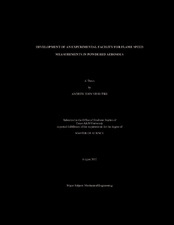| dc.description.abstract | Research with heterogeneous mixtures involving solid particulate in closed, constant-volume bombs is typically limited by the powder dispersion technique. This work details the development of an experimental apparatus that promotes ideal conditions, namely a quiescent atmosphere and uniform particle distribution, for measuring laminar, heterogeneous flame propagation. In this thesis, two methods of dispersing particles are investigated. In the first, heterogeneous mixtures are made in a secondary vessel that is connected to the main experiment. Particles are dispersed into the secondary vessel by adapting a piston-driven particle injector, which has been shown to produce uniform particle distributions. The heterogeneous mixture is then transferred to the main bomb facility and ignited after laminar conditions are achieved. In the second method of dispersion, particles are directly injected into the main experimental facility using a strong blast of compressed air. As with the first approach, enough time is given (~4 minutes) for the mixture to become quiescent before ignition occurs. An extinction diagnostic is also applied to the secondary mixing vessel as well as the primary experimental facility (for both dispersion methods) to provide a qualitative understanding of the dispersion technique. To perform this diagnostic a 632.8-nm, 5-mW Helium-Neon (HeNe) laser was employed. Aluminum nano-particles with an average diameter of 100 nm were used in this study. It was found that for typical dust loadings produced with both dispersion techniques, a pure dust-air system would not ignite due to the current spark ignition system. Thus, a hybrid mixture of Al/CH4/O2/N2 was employed to achieve the project goal of demonstrating a system for controlled laminar flame speed measurements in aerosol mixtures. With the hybrid mixture, the combustion characteristics were studied both with and without the presence of nano-Al particles. Based on the experimental results, the simplicity of the "direct-injection" methodology compared to that of the "side-vessel" is desirable and will be further investigated as a viable alternative, or improvement, to the side-vessel technology. | en |


